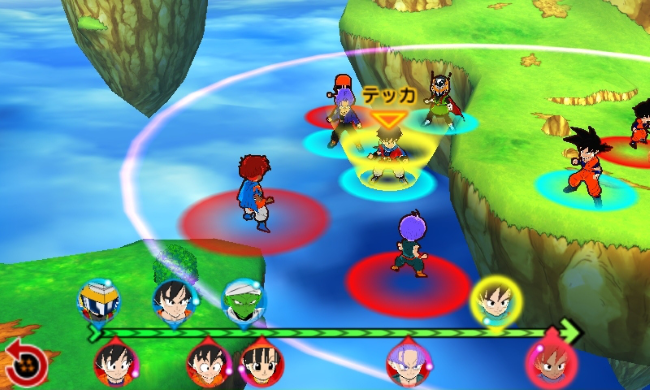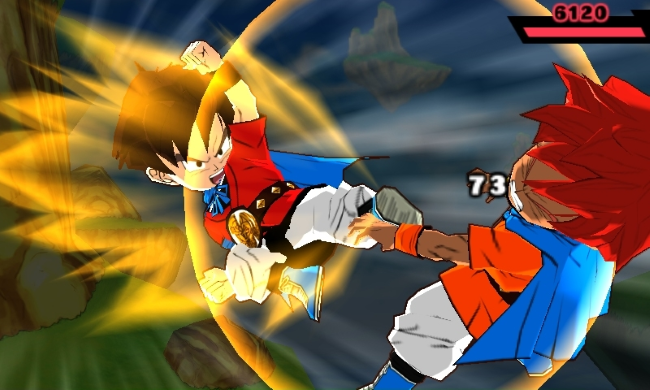
Fusions is one of the most interesting Dragon Ball games to emerge in years. It feels like a forgone conclusion for a Dragon Ball game to abide by the fighting genre, while the few that stray are predetermined to be low-budget off-shoots to sweep under the rug immediately. The thing is, Dragon Ball can work so well outside of the typical competitive brawlers it so often spawns. The Legacy of Goku series on GBA, for instance, stand among the very best of DB video games in my mind, yet failed to influence the direction of their successors. Therein lies the appeal of Dragon Ball Fusions (DBF). Here we have a turn-based strategy game revolving around party building and ability management. Pokémon with Dragon Ball characters, in theory. The perfect video game?
The conceit of DBF is recruiting characters to your five man team to compete in turn-based combat. Battles revolve around a turn-based cycle, positioning of your fighters, and a rock, paper, scissors strength hierarchy akin to Pokémon or Fire Emblem. Fights are far deeper and more involved than the typical Dragon Ball fare in theory, but their length and difficulty keep them from being nearly as fun as their core design promises. Battles last forever. Draining five characters’ enormous pools of health becomes a drag after a minute or two, but can last dozens more. Enemies are never intelligent or challenge my strategy, only withstand it for longer than I’d prefer. Difficulty comes, more commonly, in the form of unreasonable specifications. Having to beat all opponents at one time can be infuriating. I have to get everyone close enough together to use one special move on them, while all of their health is low enough, somehow accounting for their movements, without knocking them into each other and splitting the group, and beating one of them on their own causes them to respawn with full health? That’s about as fun as retrieving the Sacred Crown from Mount Rumble.

If each battle was against a notable Dragon Ball character it might lessen the pain, but most throw results of the game’s character creator at you. It’s a nice idea to flesh out encounters with these fighters that combine aspects of Toriyama’s designs in fun ways, but when each fight drags to such a tremendous bore, it isn’t at all fun. Progressing through the game means bursting through barriers, costing energy of varying colours. Said energy is collected by beating roaming foes of the corresponding colour. Sticking to the relevant and significant battles is not an option. Grinding is not only necessary but accounts for the vast majority of playtime.
Fusions, of course, play a sizable role in DBF. Ultra Fusion allows your whole squad to combine for a limited onslaught of attacks. Seeing your team combine is nothing to get excited about, though. Rather than mixing your fighters in any noticeable way, the game throws out a limited handful of designs that seem to only correlate to the races of the team in question. The same team will fuse into a random warrior of the possible few – not even the same one every time. Fusing five iconic characters could give you the same result as five default fighters. There are new two-person fusions too, though, and some of these are really fun ideas. Putting Cell and Frieza or Tapion and Future Trunks together is super cool, and having Bulla and Pan combine is neat while joining characters like Arale and Android 18 is a bit of a waste of time.

The custom-built player character and their rival kick the story off with a wish to the Eternal Dragon; for a martial arts tournament gathering all of the greatest warriors ever to exist. Of course, these fighters aren’t just pulled from any point in history, but from multiple realities. The thinly veiled excuse to create an opportunity to interact with characters from the disconnected forks of Dragon Ball continuity is forgivable as a means to an end, but the way in which it’s executed is consistently troublesome.
The localisation of Dragon Ball Fusions is atrocious. The lack of English voicing is a bummer, but totally forgivable for a game of DBF’s modest stature. The translations of the written dialogue, however, are a mess. For starters, text is squeezed into the same sized box as the original Japanese release. What results can be multiple sentences squeezed so tightly into a space that they’re hardly readable. The content of the writing is equally disappointing. Having a young Goku say “Wazzup” or “don’t worry about it, man” is hard to digest. There are a great deal of well-established characters involved, and none feel reasonably reflected here. Even when it comes close, Fusions’ sloppy translations stumble the big personalities that are cohesively defined elsewhere. Why does Master Roshi keep calling girls “sizzlers”? Can he stop?

Dragon Ball Fusions is a clever idea executed messily. The sloppy localisation keeps the characters or scenarios from being as fun as they ought to be, while the monotonous structure means things get boring before they get fun. The premise of building a team of Dragon Ball heroes, levelling them up and teaching them special attacks is a great one, and the combat system would be the perfect platform if not for their extended duration. Dragon Ball Fusion, like many Dragon Ball titles, takes a half-step towards a great idea while bogging itself down in attempts to slow down the player rather than entertain them.











